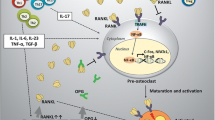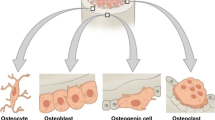Abstract
Introduction
The long treatment duration of distraction osteogenesis (DO) usually causes some complications such as re-fracture, non-union. We have previously demonstrated that the combined use of biomaterial with distraction osteogenesis technique can enhance bone formation and consolidation. This study further tested whether the use of biological agents such as rhBMP-2 or alendronate together with biomaterials in DO will further promote bone formation.
Methods
A 1.0-cm tibial shaft was removed in the left tibia of 30 rabbits. The 1.0-cm defect gap was reduced to 0.5 cm and the remaining 0.5-cm defect gap was filled with 0.5-cm restorable hydroxyapatite/tri-calcium phosphates (HA/TCP) cylindrical block. The animals were divided into three groups with the following added on the HA/TCP block: Group A 50 μl of saline, Group B 75 μg rhBMP-2 in 50 μl of saline, Group C 250 μg alendronate in 50 μl saline. The tibia was then fixed with unilateral lengthener and lengthening started 7 days after at a rate of 1.0 mm/day for 5 days. All animals were terminated at day 37 following surgery. The excised bone specimens were subject to micro-CT, mechanical testing and histological examinations.
Results
Bone mineral density and content were significantly higher in Groups A and B compared to Group C and the mechanical properties of the regenerates in Group B were highest. Micro-CT and histological examinations also confirmed that the regenerates in Group B had the most advanced bone formation, consolidation and remodeling comparing to other groups.
Conclusion
The combined use of rhBMP-2 with HA-TCP biomaterial in DO has significantly enhanced bone formation and consolidation than using the HA-TCP biomaterials alone, whereas the use of alendronate has inhibitory effects on bone formation.



Similar content being viewed by others
References
Moseley CF (1989) Leg lengthening. A. review of 30 years. Clin Orthop 247:38–43
Dahl MT, Gulli B, Berg T (1994) Complications of limb lengthening. A learning curve. Clin Orthop 301:10–18
Garcia CE, Olsen B, Ruiz Yague M et al (1992) Ilizarov technique: results and difficulties. Clin Orthop 283:116–123
Wang Y, Ni M, Tang PF et al (2009) Novel application of HA-TCP biomaterials in distraction osteogenesis shortened the lengthening time and promoted bone consolidation. J Orthop Res 27:477–482. doi:10.1002/jor.20782
Urist MR (1965) Bone: formation by autoinduction. Science 150:893–899
Sakou T (1998) Bone morphogenetic proteins: from basic studies to clinical approaches. Bone 22:591–603. doi:10.1016/S8756-3282(98)00053-2
Welch RD, Jones AL, Bucholz RW et al (1998) Effect of recombinant human bone morphogenetic protein-2 on fracture healing in a goat tibial fracture model. J Bone Miner Res 13:1483–1490. doi:10.1359/jbmr.1998.13.9.1483
Yudell RM, Block MS (2000) Bone gap healing in the dog using recombinant human bone morphogenetic protein-2. J Oral Maxillofac Surg 58:761–766. doi:10.1053/joms.2000.7261
Li G, Bouxsein ML, Luppen C et al (2002) Bone consolidation is enhanced by rhBMP-2 in a rabbit model of distraction osteogenesis. J Orthop Res 20:779–788. doi:10.1016/S0736-0266(01)00166-8
Peter CP, Cook WO, Nunamaker DM et al (1996) Effect of alendronate on fracture healing and bone remodeling in dogs. J Orthop Res 14:74–79. doi:10.1002/jor.1100140113
Li G, Simpson AHRW, Kenwright J et al (1999) Effect of lengthening rate on angiogenesis during distraction osteogenesis. J Orthop Res 17:362–367. doi:10.1002/jor.1100170310
Li G, Simpson AHRW, Kenwright J et al (1997) Assessment of cell proliferation in regenerating bone during distraction osteogenesis at different distraction rates. J Orthop Res 15:765–772. doi:10.1002/jor.1100150520
Wang Y, Wan C, Szoke G et al (2008) Local injection of thrombin-related peptide (TP508) in PPF/PLGA microparticles enhanced bone formation during distraction osteogenesis. J Orthop Res 26:539–546. doi:10.1002/jor.20495
Watanabe K, Tsuchiya H, Sakurakichi K et al (2007) Bone transport using hydroxyapatite loaded with bone morphogenetic protein in rabbits. J Bone Joint Surg Br 89:1122–1129. doi:10.1302/0301-620X.89B8.19003
Yamaguchi A, Katagiri T, Ikeda T et al (1991) Recombinant human bone morphogenetic protein-2 stimulates osteoblastic maturation and inhibits myogenic differentiation in vitro. J Cell Biol 113:681–687
Li G, Cui Y, Mcllmurray L et al (2005) rhBMP-2, rhVEGF(165), rhPTN and thrombin-related peptide, TP508 induce chemotaxis of human osteoblasts and microvascular endothelial cells. J Orthop Res 23:680–685
Li G (2004) New developments and insights learned from distraction osteogenesis. Curr Opin Orthop 15:325–330
Bergstrom JD, Bostedor RG, Masarachia PJ (2000) Alendronate is a specific, nanomolar inhibitor of farnesyl diphosphate synthase. Arch Biochem Biophys 373:231–241
Little DG, Smith NC, Williams PR et al (2003) Zoledronic acid prevents osteopenia and increases bone strength in a rabbit model of distraction osteogenesis. J Bone Miner Res 18:1300–1307. doi:10.1359/jbmr.2003.18.7.1300
Greiner SH, Wildemann B, Back DA, Alidoust M, Schwabe P, Haas NP, Schmidmaier G (2008) Local application of zoledronic acid incorporated in a poly(d, l-lactide)-coated implant accelerates fracture healing in rats. Acta Orthop 79(5):717–725
Greiner S, Kadow-Romacker A, Wildemann B, Schwabe P, Schmidmaier G (2007) Bisphosphonates incorporated in a poly(d, l-lactide) implant coating inhibit osteoclast like cells in vitro. J Biomed Mater Res 83(4):1184–1191
Sloan AV, Martin JR, Li S et al (2010) Parathyroid hormone and bisphosphonate have opposite effects on stress fracture repair. Bone 47(2):235–240. doi:10.1016/j.bone.2010.05.015
Matos MA, Tannuri U, Guarniero R et al (2010) The effect of zoledronate during bone healing. J Orthop Traumatol 11(1):7–12. doi:10.1007/s10195-010-0083-1
Acknowledgments
We thank Mr. Jason Hendry, Millenium Biologix Corporation, Kingston, Canada for providing the cylindrical Skelite™ scaffolds for this study.
Author information
Authors and Affiliations
Corresponding authors
Rights and permissions
About this article
Cite this article
Ni, M., Li, G., Tang, PF. et al. rhBMP-2 not alendronate combined with HA-TCP biomaterial and distraction osteogenesis enhance bone formation. Arch Orthop Trauma Surg 131, 1469–1476 (2011). https://doi.org/10.1007/s00402-011-1357-7
Received:
Published:
Issue Date:
DOI: https://doi.org/10.1007/s00402-011-1357-7




